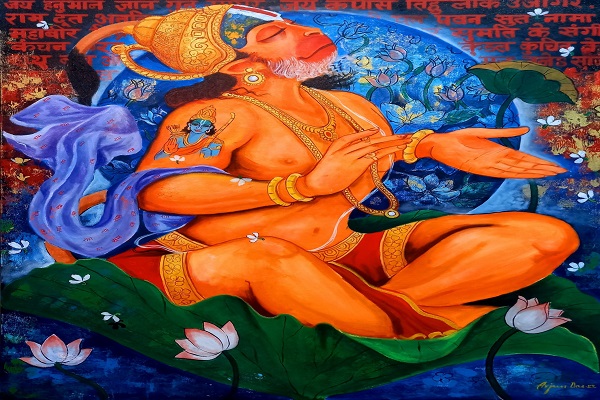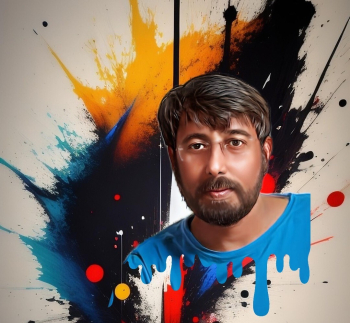
Floating objects or people in contemporary paintings challenge our conceptions of reality and evoke a sense of curiosity and wonder. These pieces of art provide a surreal impression that defies physics principles, transporting the observer beyond the boundaries of our physical reality. Using optical illusions, perspective, and negative space, the sensation of weightlessness and freedom is created.
This painting style delves into topics such as the longing for transcendence, escape, and weightlessness. The use of brilliant hues, detailed details, and textures contributes to the hypnotic impact of these paintings. Aside from the aesthetic approaches used, these paintings allow viewers to stretch their imaginations and discover new ways of experiencing the world. They motivate us to think beyond our physical world and embrace the beauty and mystery of the unknown. And today we see many such types of painting in Online art galleries.
Technique Used to Create Floating Painting
Creating a dreamlike illusion of floating is a technical challenge that necessitates a blend of creative abilities and ingenuity. One of the techniques employed is optical illusions, in which the artist manipulates the viewer's visual perception to create the illusion of things floating in mid-air. Another way is to utilize perspective, which involves painting objects from a precise angle to give the appearance of depth and distance. Negative space is also employed to create a sensation of emptiness and weightlessness by leaving the area around the subject vacant or white.
Many well-known artists have leveraged these techniques to produce breathtaking and captivating works of art. For example, Salvador Dali's "The Persistence of Memory" uses perspective and negative space to depict melted clocks floating in space. In Rene Magritte's "The Son of Man," an apple obscures a man's face, giving the impression that he is hovering in mid-air. These and other paintings exhibit the employment of diverse techniques to achieve the surreal illusion of floating, provoking the viewer's amazement and interest.
The Deeper Meaning Behind Floating Paintings
The appearance of objects or individuals floating in mid-air is more than simply a visual trick in the field of art. It is a method of expressing the universal aspiration for freedom, weightlessness, and transcendence. Floating things in paintings inspire our imagination and urge us to seek new ways of viewing the world.
Floating paintings defy our ideas of reality and entice us into a world of mystery and magic. They reveal to us that there is more to life than what our physical eyes can see. These paintings encourage us to think beyond the box, imagine the impossible, and strive for a better understanding of our role in the cosmos.
Floating paintings, in essence, are an expression of art's potential to challenge and broaden our perceptions, enabling us to see the world through new eyes and appreciate the beauty and wonder of our existence.
Interesting Blog: 5 Reasons Why Contemporary Art Paintings Are Important
The Creative Process of Floating Paintings
We spoke with modern painters who specialized in floating paintings to gather insight into the creative process. These artists contributed their insights, innovative ideas, and approaches.
The creative process, according to these artists, begins with a concept, which is frequently motivated by personal experiences or feelings. They then carefully choose their tools, like canvas, paint, and brushes, to bring their concept to life. They use methods like negative space, perspective, and optical illusions to create the appearance of floating. The technique is fraught with trial and error as they strive for the exact combination of colors, texture, and composition.
These artists also discussed their inspirations, which range from nature to dreams and surrealism. They talked of the gratification of seeing their ideas come to life on canvas and the joy of producing something that challenges and inspires others.
These artists illustrate the ability of art to communicate emotions, encourage thinking, and take audiences to new realms of imagination via their creative process.
The Future of Floating Points
As technological advancements persist in their evolution, they hold the potential to transform the ways in which we craft and showcase floating paintings. Emerging technologies, such as virtual reality and projection mapping, present novel opportunities for artists to augment the surreal impact of their oeuvres and generate immersive experiences for their audience. Moreover, such technologies may allow for greater interactivity, empowering viewers to delve into floating paintings in unprecedented, enthralling ways.
The future of floating paintings harbors the potential for inspiring new genres of art and creative expression. The application of novel materials and technologies may empower artists to transcend the limitations of what is deemed possible, resulting in works that are even more remarkable and provocative. Furthermore, the ascendancy of floating paintings may inspire a new crop of artists to explore the theme of weightlessness and freedom in their own singular manners.
In conclusion, the prospects of floating paintings in the future are imbued with thrilling possibilities. As technology propels forward, we can anticipate that novel and innovative ways of generating and experiencing this captivating style of art will emerge. Whether through virtual reality or newfangled forms of artistic expression, the surreal impact of floating paintings will endure in captivating the imagination of audiences for generations to come.
Read More: Top 8 Indian Contemporary Artists Shaping the Future of The Industry
Final Thoughts
The present article has undertaken an in-depth exploration of the captivating and intriguing world of contemporary paintings that feature floating objects or figures. The discourse has comprehensively analyzed the complex techniques that skilled artists employ to create the surreal effect of floating, while also shedding light on the profound symbolic significance that this theme holds in the domain of art.
Furthermore, the article has elucidated the intricate and multifaceted creative processes that contemporary artists use to produce such thought-provoking artworks. In addition, the potential of advanced technology to augment the creation and display of floating paintings has been cogently discussed, along with the possibility of this art form catalyzing the emergence of new and exciting forms of artistic expression.
In addition, the article has underscored the truly unique and spellbinding nature of floating paintings, which can captivate viewers and challenge their perception of reality, urging them to ponder beyond the boundaries of the material world. The utilization of cutting-edge materials and techniques presents limitless opportunities for artists to expand the scope and horizons of their creative endeavors, paving the way for the emergence of even more mesmerizing and thought-provoking artworks.





















